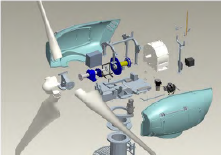Goal: Form a consortium of distributed wind energy equipment manufacturers, suppliers, customers, and university researchers and develop a roadmap that identifies common manufacturing gaps, prioritizes actions to close these gaps, and fosters rapid transfer of solutions.
Background: Unlike centralized wind farms, which feed power to utility transmission lines, distributed wind systems provide power to nearby homes, farms, industrial facilities, or other end users. These users may be located "off the grid" or tied into the grid. Since most of the world does not have centralized power, the potential global market for distributed wind energy systems is large, which DWEA forecasts to grow to $2 trillion by 2030. U.S. manufacturers of these systems are world leaders in what is still a small global market. However, foreign manufacturers have entered the market, many with systems that mimic the design of U.S. technology.
To maintain their edge in a growing global market, U.S. manufacturers need to accelerate research and development efforts aimed at improving production processes and driving down component costs. Distributed wind energy’s technical challenges are substantial and distinct from those of utility wind. Utility‐scale wind turbines have become more cost‐effective, in part due to increased investments in R&D. Many of those cost‐effective concepts may be relevant and applicable for distributed wind technology, as outlined in the SMART Wind Roadmap.
Approach: To help the U.S. distributed wind energy industry prioritize its R&D goals, DWEA launched the Strategies for Manufacturers Advancing Research and Technology (SMART) Wind Consortium. The SMART Wind Consortium: comprised over 80 organizations spanning the distributed wind industry's entire value chain—manufacturers and developers of technology, researchers, and installers and end users; conducted meetings with members of four consortium subgroups: mechanical subsystems, support structures, electrical subsystems, and composite subsystems; strategized to identify common gaps and barriers and potential technology and manufacturing process improvements that could be used for distributed wind turbines; prioritized solutions to those gaps and opportunities; and identified ways to facilitate transfer of innovation into American-made wind turbines to reduce cost while maintaining high quality and value and strengthen U.S. distributed wind manufacturing global competitiveness.
Outcome: The SMART Wind Roadmap focuses on four key aspects of manufacturing performance—mechanical systems, composites, electrical systems, and support structures. The roadmap identifies and prioritizes more than 170 potential action steps in the following priority‐ranked areas:
- Optimize and harmonize wind turbine designs to improve cost of energy and achieve parity with U.S. retail electricity rates in more markets
- Improve manufacturing parts, materials, and processes, including incorporating lean manufacturing practices
- Optimize standards and certification to enable technology evolution and maintain quality
- Streamline installation and maintenance of wind turbine systems
- Sustain SMART Wind Consortium activities and partnerships
The consortium interacted with IACMI, The Composites Institute (a Manufacturing USA® institute) in the development of the roadmap . The SMART Wind Roadmap is expected to replace the “U.S. Small Wind Turbine Industry Roadmap,” prepared in 2002 by the American Wind Energy Association for the U.S. Department of Energy, as an industry-driven guide to assist funders and investors in selecting R&D activities in distributed wind energy.
The Roadmap recommendations will help U.S. manufacturers accelerate R&D efforts aimed at improving production processes, driving down component costs and helping them stay ahead of growing competition in the field.
Lead: Distributed Wind Energy Association (DWEA)
Funded Participants: Mary Childress CPA, Consultant (Washington, D.C.); eFormative Options (Vashon, Wash.); WindyGlick Communications (Washington, D.C.); Wind Advisors Team (Broomfield, CO)
Award Number: 70NANB14H047
Federal Funding: $488,634
Project Duration: 24 months
AMTech Project Manager: Thomas R. Lettieri
More information: http://distributedwind.org/smart-wind-consortium/smart-wind-project-overview/


